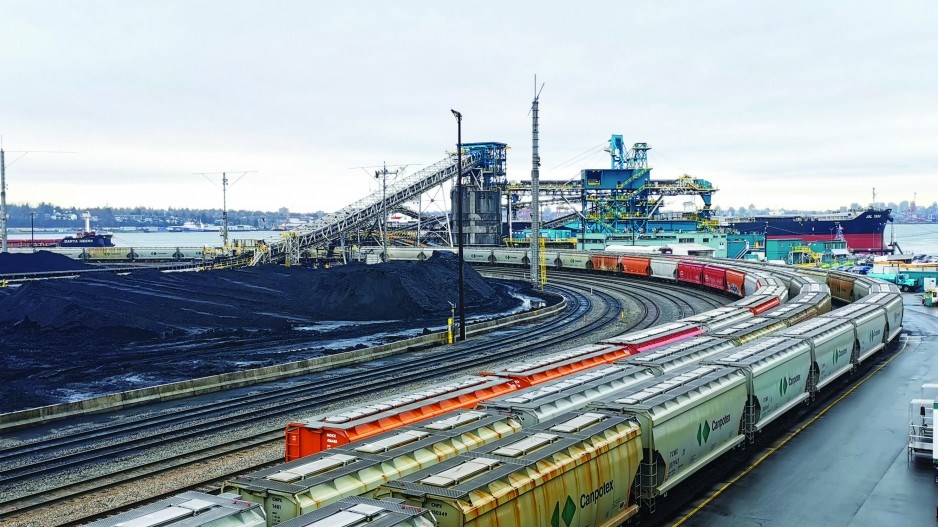B.C. exports reached a record level in dollar value in 2022, largely due to higher fossil fuel prices, and thus representing a double-edged sword for the provincial government, says a climate change policy expert.
Whereas the provincial government has reaped the benefits of high fossil fuel prices boosting its bottom line for social program spending, it must also face the consequences of those revenues declining due to dwindling supply, least to mention the impact burning these products will have on the climate, said Kathryn Harrison, a political scientist at the University of B.C.
“I think at minimum we need to be making economic plans, with a longer-term view, that are anticipating what could happen to the international markets for our fossil fuel exports,” said Harrison.
“The prosperity from those exports is fragile, and it needs to be fragile if we’re going to have a livable planet,” added Harrison after looking at the data presented in the Annual B.C. Origin Exports report from Feb. 7.
Export values hit $64.5 billion in 2022, shattering the record of $53.9 billion in 2021 and leaving the pre-pandemic five-year average of $41.3 billion in its dust.
B.C. energy producers sold $23.9 billion worth of energy products, compared to $11.8 billion in 2019. Natural gas ($11.9 billion) and coal ($7.4 billion) represented most of those sales, which directly result in higher corporate taxes and royalties.
The higher values are attributed to higher global prices, according to the 2023 budget document for 2023-2024 fiscal year: “Energy exports to both the U.S. and non-U.S. destinations were a main driver of total exports growth in 2022, supported by higher prices for natural gas and coal.”
Metallurgical coal prices, noted the budget, had shot up 63 per cent in 2022.
Likewise, wood products contributed to much of the rest of B.C.’s record export values in 2022, as $7.3 billion of softwood lumber was sold compared to $4.8 billion in 2019 (lumber prices declined in the last half of 2022).
The report only states dollar values and not product quantities and the provincial government doesn’t track that data.
However, the most recent published data from Port Metro Vancouver shows in the first half of 2022, thermal coal exports sat at nine million units compared to 5.6 million units in the first half of 2021.
The 2022-2023 budget initially estimated total revenue from “energy, sales of Crown land tenures, metals, minerals and other” to be $1.8 billion but the second quarter forecast turned out to show $3.8 billion of revenue.
Last November, the Ministry of Finance announced a second quarter $5.7-billion anticipated surplus to the end of the fiscal year, up from $700 million in the first quarter.
B.C. Premier David Eby indicated at the time he intends to spend the surplus on government programs by March 31, before any surplus must legally be retired to provincial government debt. So far this year, for example, Eby announced a $1-billion fund for municipalities and a $500-million fund to provide a $400 subsidy to low-income renters.
Meanwhile, the B.C. government continues to promote its CleanBC plan to lower climate-changing emissions by 40 per cent below 2007 levels, by 2030.
Harrison said the increased fossil fuel revenues turning into social program spending and outright tax credits “bring to the fore a very big tension in British Columbia and also in Canada between our continued reliance on prosperity driven by fossil fuel production for export, even as we commit to getting to net zero” carbon emissions.
But the sidestepping will become more difficult in the next two decades as “the emissions from just digging the stuff out of the ground loom” on domestic emission targets, said Harrison.
According to the 2023 budget, natural resource prices are expected to lower this year, leaving the government with less revenue. In fact, the trend started in the last half of 2022, as the fourth quarter saw an 11.9 per cent decline despite the record total.
But a rebound is being pencilled in for 2024 as total exports continue to grow.
“Strong export growth is forecast to continue in B.C. as Canada’s first LNG terminal moves into production in the medium-term,” the budget noted, adding: “Real exports of goods and services are estimated to have grown by 6.3 per cent in 2022, following an increase of 3.2 per cent in 2021. Growth in real exports of goods and services is projected to be 2.8 per cent in 2023, 3.0 per cent in 2024, and range between 2.6 per cent and 5.2 per cent annually in the 2025 to 2027 period. The anticipated production of LNG toward the end of the forecast horizon provides support to the outlook.”
Harrison said geopolitical factors are at play in how B.C. will handle its new liquefied natural gas (LNG) exports. China could latch on to Russia in the near term, said Harrison, while trading with that nation has also become less popular among Canadians. Meanwhile, the U.S. Inflation Reduction Act anticipates a significant decline in gas consumption, said Harrison.
The B.C. government has announced a trade diversification strategy but has not provided benchmark metrics for its goals — be it what commodities or destination countries it wants to lessen or strengthen its reliance on.
“As part of the Stronger BC Economic Plan, we are developing a Trade Diversification Strategy, which will identify high-value opportunities in markets where B.C. businesses are competitive and in markets that align with our social, environmental and economic values,” stated the Ministry of Jobs, Economic Development and Innovation in response to questions from Glacier Media.
“The Strategy,” stated the ministry, “will focus on priority sectors that have high export and investment impacts, regional economic development benefits, reflect value-added, inclusive opportunities, and consistent with characteristics supporting sustainability. It will also empower businesses to connect with more international partners to create more jobs and prosperity in B.C.



